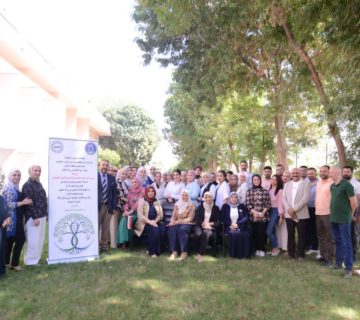The Assistant Dean of the Institute of Genetic Engineering and Biotechnologies for Postgraduate Studies / University of Baghdad for Administrative and Scientific Affairs, Assistant Professor Dr. “Ismail Hussein Aziz”, participated in the membership of a scientific committee to discuss the doctoral thesis of the student at the College of Veterinary Medicine “Ali Muhammad Abboud” tagged (Clinical diagnosis and molecular profiling of nodular skin disease in buffaloes in the governorates of Wasit, Dhi Qar and Maysan).
The study aimed to confirm the presence of clinically, molecular and histological lumpy skin disease (LSD) in buffalo in three Iraqi governorates for the first time in Iraq. In total, 300 buffaloes were selected from different regions in three Iraqi provinces that included 100 animals from Wasit, 100 from Maysan and 100 from Dhi Qar.
This study involved drawing blood samples from 150 animals as well as collecting skin lesions from all study buffaloes.
The aim of the clinical examination of all study animals (300 buffaloes) was to measure vital signs (body temperature, pulse and respiratory rates), detect skin lesions, and collect ticks. Blood samples, skin biopsies and ticks were collected for molecular examination using conventional qualitative polymerase chain reaction (PCR) and quantitative real-time (qPCR). In addition, skin lesions were histologically examined using hematoxlin and eosin dye as well as histomegastre amion testing, while tick samples were phenotypic examined for the purpose of classification.
The results of this total study of the examination of 300 buffaloes by qPCR technology showed that the total positive animals reached 31 (10.33%) of which 23 (15.33%) in 150 blood samples, and 9 (5.52%) in 163 skin lesions. Whereas positive samples for conventional PCR technology for screening 300 animals were 14 (4.67%) included 8 (5.33%) in 150 blood samples, and 6 (3.68%) in 163 suspected skin lesions. Molecular examination of tick samples collected from 81 buffaloes showed no positive samples by both conventional PCR and qPCR tests.
This study concluded that the morphological classification of the tick samples collected that the species is Hyalomma anatolicum for all samples collected.









